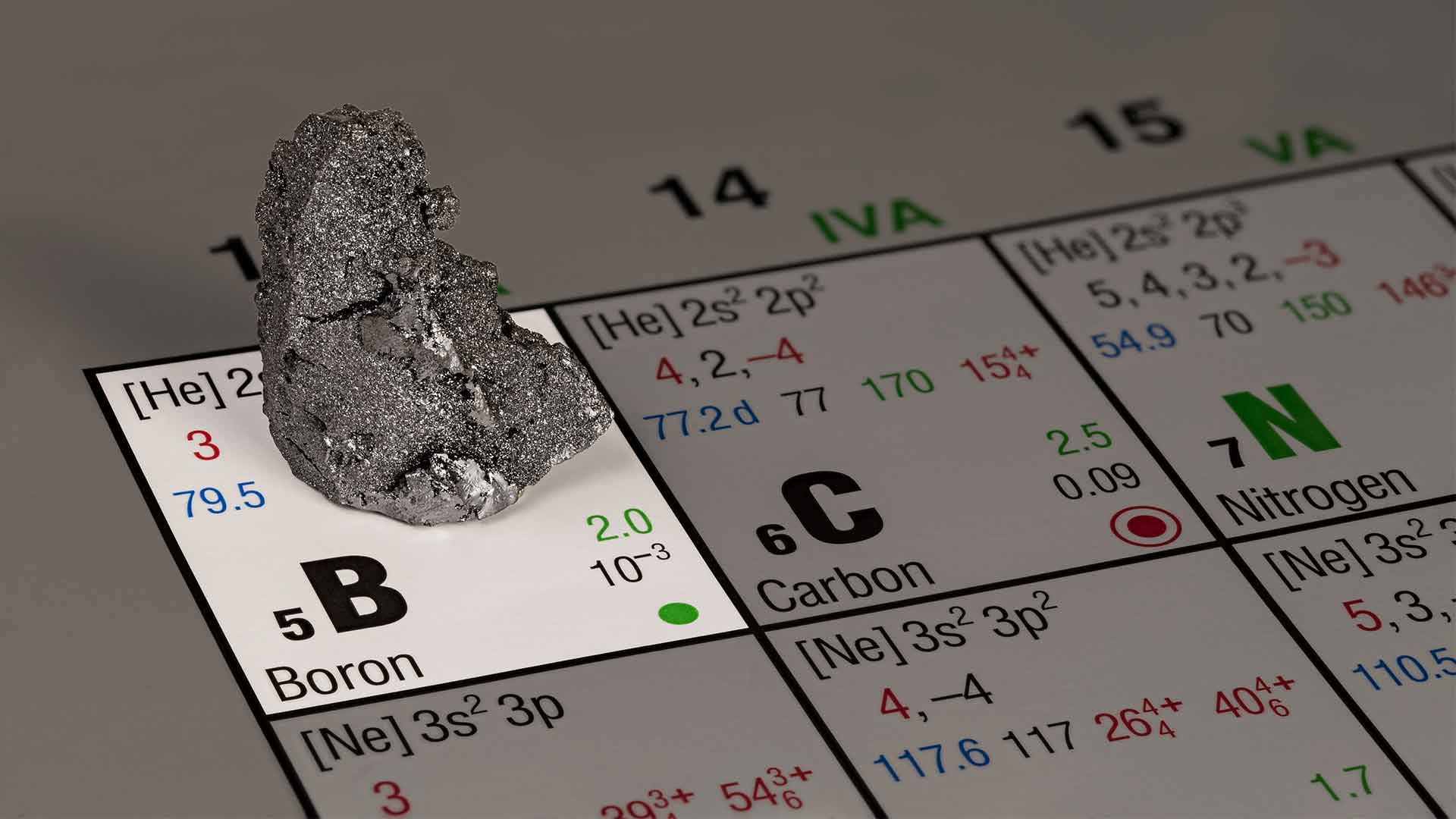What is Boron?
What is Boron? Boron is a chemical element with symbol B and atomic number The name derives from the Arabic buraq for “white”. Although its compounds were known for thousands of years, it was not discovered or ‘isolated’ until 1808 by the French chemists Louis-Joseph Gay-Lussac and Louis-Jacques Thenard, and independently by Sir Humphry Davy, an English chemist, in 1808 who isolated boron by combining boric acid (H3BO3) with potassium. Nowadays, boron is obtained by heating borax (Na2B4O7·10H2O) with carbon, although other methods are used where high-purity boron is needed.

Origins of Boron
Boron may have been the key to the evolution of life on Earth. The element stabilizes ribose, part of RNA, the self-assembling molecule that may have preceded DNA. A June 2014 study found that boron is present in rocks that date back to 3.8 billion years ago. Boron has also landed on our planet from Mars. A Martian meteorite that landed in Antarctica contained significant traces of boron.
Boron is an orthoboric acid in some but not all volcanic spring waters and borates in the minerals borax and colemanite. Extensive borax deposits are found in Turkey, which has the largest borax deposits. Still, rasorite is the most important source of boron, found in extensive deposits in California, USA, in and around the Mojave Desert.
Elemental Boron
Elemental Boron is a low-abundance element in the Solar System and in the Earth’s crust (about 0.001 percent by weight of Earth’s crust). Boron is a metalloid found in small amounts in meteoroids, but chemically uncombined boron is not otherwise found naturally on Earth. Industrially, the very pure element is produced with difficulty because of contamination by carbon or other elements that are reputed to resist removal.
The Boron Group
Belonging to the Boron Group are the chemical elements in group 13 of the periodic table: boron, aluminum, gallium, indium, thallium, and some include nihonium. The elements in the boron group all have three valence electrons (or triels).
Boron
Boron is a chemical element with symbol B and atomic number – number of protons in the nucleus – 5. Classified as a metalloid, boron is a solid at room temperature. It has an atomic weight as follows:
The Atomic weight (average mass of the atom) is 10.81 with a density of 2.37 grams per cubic centimeter. Ar(B) = [10.806, 10.821].
The melting point of Boron is 3,767 degrees Fahrenheit (2,075 degrees Celsius).
Its boiling point is 7,232 degrees F (4,000 degrees centigrade).
Several allotropes exist, including α-rhombohedral B, β-rhombohedral B, γ-B, tetragonal boron
– Amorphous boron is a brown powder
– Crystalline boron is silvery to black, extremely hard (about 9.5 on the Mohs scale), and a poor electrical conductor at room temperature.
Natural Boron
Natural boron is composed of two stable isotopes, one of which (boron-10) has several uses as a neutron-capturing agent. The number of isotopes – atoms of the same element with a different number of neutrons – is 6. The most common isotopes are B-10 (natural abundance 19.9 percent) and B-11 (natural abundance 80.1 percent).
Boron Compounds – Boric Acid and Borates
Boron is the lightest element of the boron group (above), with three valence electrons that form covalent bonds to produce several compounds, including:
– Boric acid – all Borates are derived from Boric Acid
– Borate Salts, including the mineral Borax and Sodium Metaborate
– The ultra-hard crystal Boron Carbide
Boric Acid ->Borates
Borates are the form in which boron most often occurs in nature, mainly as borate minerals and borosilicates. The incomplete octet means that Borates act as Lewis acids. When a trigonal boron atom accepts a pair of electrons from a Lewis base, it adopts a tetrahedral configuration, and the octet rule is satisfied.
B- Boric Acid is an inorganic acid. Boric acid is a weak proton donor – it can accept an electron pair. In water, it behaves as a Lewis acid, accepting the electron pair of a hydroxyl ion produced by the water autoprotolysis. It is acidic because it reacts with OH− from water, forming [B(OH)4]− and releases the corresponding proton left by the water autoprotolysis.
B(OH)3 + 2 H2O ⇌ [B(OH)4]− + [H3O]+ (pKa = 8.98)
All borates are considered derivatives of boric acid B(OH)3.
The simplest borate anion, BO33-, has a trigonal planar structure and is analogous to the carbonate anion CO32-, which is isoelectronic. Larger borates are composed of trigonal planar BO3 or tetrahedral BO4 structural units, joined together via shared oxygen atoms, and may be cyclic or linear in structure.
Boron trioxide is one of the oxides of boron; it is a white, glassy solid with the formula B2O3. Glassy boron oxide is thought to be composed of boroxol rings, which are six-membered rings of alternating 3-coordinate boron and 2-coordinate oxygen. The short bond lengths and strong covalence give boron suboxide ( B6O) amazing physical and chemical properties: Hardness, low mass density, high thermal conductivity, high chemical inertness, and resistance to wear.
Metal Borates
Several metal borates are cataloged. Metal Borates are produced by treating boric acid or boron oxides with metal oxides.
– diborate [B2O5]4−, found in Mg2B2O5 (suanite),
– triborate [B3O7]5−, found in CaAlB3O7 (johachidolite),
– tetraborate [B4O9]6−, found in Li6B4O9.
Metaborates, such as LIBO, contain chains of trigonal BO3 structural units, each sharing two oxygen atoms with adjacent units, whereas NaBO2 and KBO2 contain the cyclic [B3O6]2− ion.
Borate Salts ->Borax & Sodium Metaborate
Common borate salts (Sodium Borate is the sodium salt of Boric Acid) include sodium metaborate and borax. The borax chemical formula is also commonly written in a more compact notation as Na2B4O7·10H2O. Sodium borate can be obtained in high purity. Borates are either triagonal (BO3) or tetrahedral (BO4) and either cyclical or linear in structure, joined by shared oxygen atoms. The simplest borate anion, the orthoborate(3−) ion, [BO3]3−, is known in the solid state, for example, in Ca3(BO3)2, where it adopts a nearly trigonal planar structure.
Borax
Borax, also known as sodium borate, sodium tetraborate, or disodium tetraborate, is a boron compound, a mineral, and a salt of boric acid. Powdered borax is white, comprising soft colorless crystals that dissolve in water. It is used in cleaners, detergents, and cosmetics. It is found in locations where rainfall is very low such as Turkey, Chile – Atacama Desert, California – Death Valley, and the Mojave desert.
Sodium Metaborate
Sodium metaborate is a colorless solid compound (sodium, boron, oxygen – NaBO2). It is commonly used to manufacture borosilicate glass, also known as pyrex. Here, some silicate [SiO4]4− units are replaced by [BO4]5−. Because this substitution has imperfections, the material forms a glass with a low coefficient of thermal expansion, being less brittle and resistant to cracking.
Boron Carbide
A highly complex structure with a chemical composition estimated as B4C, Boron Carbide is always slightly carbon-deficient. It is an extremely hard boron carbon ceramic and covalent material. Its structure makes it appropriate for military applications – bulletproof vests, tank armor, and gun coatings. It is one of the hardest known materials, after cubic boron nitride and diamond.
Other forms
Boron Nitride Nanotubes
Research shows that Boron Nanotubes (BNNTs) have extraordinary mechanical, optical, and thermal properties. They are gaining considerable attention from various scientific fields, promising as a potential nanomaterial more than other nanotubes. Recent research has shown that BNNTs have better properties than carbon nanotubes. These are well-studied for many applications in the environment-energy field. BNNTs demonstrate better electrical insulation properties, wetting, mechanical strength, thermal resistance, and. These properties can benefit electronic, drug delivery, nano-medicine, biomedical, aerospace, energy, and environmental applications.
Borophene
Borophene is a single layer of a boron atom, with exciting research underway. Borophene has a wide range of potential applications among alkali metal ion batteries, Li-S batteries, hydrogen storage, supercapacitor, sensor, and catalytic in hydrogen evolution, oxygen reduction, oxygen evolution, and CO2 electroreduction reaction.
Uses
Boron primarily uses boron fibers with applications similar to carbon fiber in some high-strength materials. About half of all products consumed globally is an additive in fiberglass for insulation and structural materials.
The next leading use is in polymers and ceramics in high-strength, lightweight structural, and heat-resistant materials. Borosilicate glass is desired for its greater strength and thermal shock resistance than ordinary soda lime glass.
As sodium perborate, it is used as a bleach.
A small amount is used as a dopant in semiconductors and reagent intermediates to synthesize organic fine chemicals.
The element itself primarily uses boron fibers with applications similar to carbon fiber in some high-strength materials. It
The isotope boron-10 has properties that allow it to absorb neutrons, making it useful for controlling nuclear fission, driven by careening neutrons knocking uranium atoms apart. Boron absorbs excess neutrons reducing exposure to uranium atoms, so every fission event triggers just one more. Nuclear reactors are equipped with control rods made of boron.
Research
Boron may be a boon to tech as well. In July 2014, researchers discovered the first boron “buckyball,” a cagelike structure similar to the soccer-ball-shaped carbon buckyballs often used in nanotechnology. Carbon nanostructures (known as fullerenes) were first discovered in the 1980s, and they prompted a wave of research in the hunt for other intriguing atom clusters.
“If you look at the main group elements, there is no better place to start than boron,” said Lai-Sheng Wang, a chemist at Brown University who discovered the first boron buckyball. Boron atoms bond strongly with each other, Wang told Live Science, and the element has a very high melting point. It’s tough stuff.
Boron Clusters
Wang’s research team put clusters of boron atoms to examine the shapes as they bonded. They achieved this by using lasers to pull electrons from the cluster. By measuring the dislodging speed, they could map out the structure – borospherene’.
With up to 39 boron atoms bonded together, the structure is flat. Still, when 40 or more are bonded, the structure becomes a spherical cage, a spherelike “cage,” the researchers reported in Nature Chemistry.
Flat Boron
Some of the boron’s flat structures can be very useful. Scientists found that 36 atoms will form a disk with a perfect hexagonal hole in the middle — an arrangement that theoretically makes it possible to create a stable, one-atom-thick sheet of boron, the boron equivalent of graphene, which is an atom-thick sheet of carbon molecules. Graphene holds a great deal of promise for tech because it is a cheap, strong, flexible conductor
Spherical Boron – Borophene
Borophene is being researched for its potential as a superconductor – electrical and thermal – with boron sheets in flat layers to create more efficient conduction substrates. This has applications for semiconductors, batteries, and powertrains powered by neodymium magnets.





